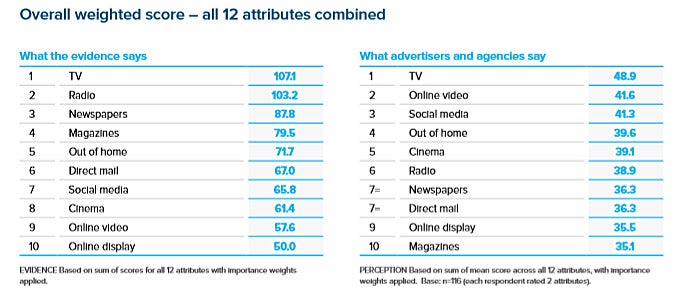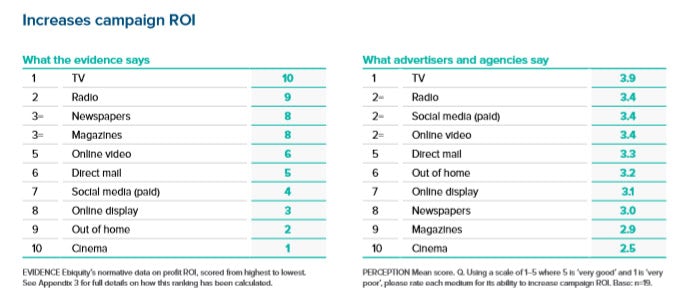Marketers undervalue the impact of traditional media channels
Radio and print perform significantly better than advertisers and agencies expect for brand building campaigns, while online media is all too often overvalued.

Marketers are overestimating the effectiveness and value of digital media channels such as online video and social media compared to more traditional formats such as TV, according to a new study.
Calling for a re-evaluation of where marketers spend their budgets, new research from Radiocentre and Ebiquity highlights a disconnect between the scale of investment pumped into online media and the value it delivers. It also reveals key industry decision-makers are significantly undervaluing traditional forms of media.
With the exception of TV, which is the only medium where perceptions match the evidence, newspapers, magazines and radio are all much better at building brand campaigns than advertisers and agencies think, while online video and social media deliver much less value than they are perceived to.
READ MORE: Mark Ritson – Marketers are clueless about media effectiveness – here’s the proof
Radio, for example, came sixth in the ranking of advertiser and agency perceptions. Yet it is the second most valuable medium for brand building campaigns according to the data (see chart below).

Similarly, few respondents were positive about newspapers’ and magazines’ ability to generate ROI, and yet they yield the best returns overall behind TV and radio. And while marketers think paid social media and online video come in joint second along with radio, the evidence suggests online video is actually the fifth most effective at generating ROI and paid social media seventh.

In terms of audience measurement, online video and online display were rated the highest of any channel by marketers for their ability to measure response instantly and in detail. However, print, TV and radio came out on top again when examining the evidence.

“Across each of [the categories], there are quite big variants across perception and reality,” Radiocentre’s planning director, Mark Barber, explains.
“That shows that in an increasingly complex media landscape, where people are under planning pressures, there is an increasing specialisation required that people are using more and more mental short cuts to navigate their way through this complexity.”
To gather the results, 116 senior executives working for brands and agencies were given a list of 12 attributes and forced to trade them off against one another to determine what they think are the most, and least, important for growing a brand over the long term.
Targeting the right people in the right place at the right time, increasing campaign ROI, triggering a positive emotional response, increasing brand salience and maximising campaign reach came out on top.
Getting ads noticed, being able to guarantee a safe environment, transparent third-party audience measurement and low production costs were seen to be less important.

The majority of respondents believe the shift towards digital spend will continue – partly driven by established media audiences moving to digital platforms. However, some feel this trend will slow as a result of GDPR and concerns around brand safety.
While Barber says a slowdown is an “inevitable natural consequence” as the digital market reaches maturity, he believes marketers are also beginning to re-examine the effectiveness of media and shifting budgets accordingly.
“There is a lot of evidence already available in the public arena examining the efficacy of individual media across a range of criteria but, like with most things online, you need to know what you’re looking for to find it,” Barber adds.
“This study brings all of that data together in one place, making it easier for industry decision-makers to review current trends and make more informed evidence-based choices to optimise future media plans. In doing so, we hope that radio will rightfully be considered more often for brand-building campaigns.”






